Most Canadian investors use a financial advisor or a bank and invest their money in mutual funds. When it is time to sell, they just have to call their advisor and ask them to do the sell.
Selling individual stocks or ETFs (exchange traded funds) at a Canadian discount brokerage is a bit more complicated because you have to enter the sell order yourself instead of just telling someone else to do it.
If you own a stock or ETF, then you obviously figured out how to buy a stock or ETF at your discount brokerage. Sell orders are a bit different than purchases and this article might come in handy if it’s been a while since you have placed a trade of any kind.
Choosing a discount broker? See the comprehensive Canadian discount brokerage fee comparison.
How to buy an ETF or Stock using a Canadian discount brokerage – step by step instructions.
General steps:
Decide what to sell. It’s out of scope for this article, but you should know which stock or ETF you wish to sell.
Sell a stock or ETF. This is the topic which will be detailed here. I’ll be using the interface at Questrade discount brokerage to demonstrate how to make a trade, but whatever brokerage you use should have something similar. If you notice differences with your brokerage, please let me know and I’ll add that information to this article.
Here are the steps to sell a stock or ETF.
1) Know which security you wish to sell and how much.
I’m assuming at this point, you already know what stock or ETF you want to sell.
In my case, I wish to sell a real estate investment trust security that I own called RioCan. I have 204 shares of RioCan and I wish to sell all of them. This will be the example security I’m going to use for this article.
2) Find out the stock ticker symbol for the security
Every security that trades on a stock exchange will have a stock ticker symbol. This symbol will be needed to enter the sell order.
Since you already own the security, finding the stock trading symbol should be as simple as looking at your discount brokerage account.
In my Questrade account I log into the trading platform QuestraderWeb. I select “Positions” and I can see that the Symbol for RioCan is “REI.UN.TO”. Note that the “.TO” suffix refers to the Toronto Stock Exchange.
3) Find out which exchange the security trades on
There are different stock exchanges in different countries and the security you want to sell will be traded on one or more exchanges.
If the security you wish to sell is Canadian, it will likely be traded on the TSX (Toronto stock exchange) and you have to select that stock exchange when making the order. In the case of Questrade, you don’t select the exchange – you just include the “.TO” extension for any trades. If the security is American (such as a Vanguard ETF), you don’t need an extension – just enter the basic ticker symbol (ie VTI for the Vanguard total American stock ETF).
In my case, the REI security trades on the Toronto stock exchange. I need to use “REI.UN.TO” when attempting any trading of this security with Questrade.
Understand that some stocks are traded on both the Toronto stock exchange as well as the New York stock exchange. If we look at Bank of Montreal, the symbol “BMO.TO” is the ticker symbol of the security that trades on the Toronto stock exchange. The symbol “BMO” is the ticker symbol of the security that trades on the New York stock exchange. Make sure you use the proper ticker symbol and select the proper exchange!
Note that other discount brokerages have their own methods of notating the exchange.
- Questrade – For TSX stocks, use the suffix “.TO” ie XRB.TO, for NYSE – use basic symbol ie XRB.
- RBC Direct and TD Waterhouse – Choose the desired exchange and then enter the basic symbol ie XRB.
- Interactive Brokers – Enter basic symbol and choose the appropriate choice from the list. Ie enter “RY” and you will see a list of exchanges.
Some brokerages will have shortcut links in the “positions” or “balances” page which will allow you to easily sell shares of any stock you currently hold.
5) Find the security price and calculate how many shares you should sell
Typically when an investor wants to sell a stock or ETF, they either want to sell a specific dollar amount or they want to sell their entire position.
If you want to sell all your shares, you just need to determine how many shares you own. If you look at the screen shot just above, you can see that I have 204 shares of REI.
If you want to sell a specific dollar amount of shares, you have to find out the most recent price for the security and calculate how many shares to sell. Unlike mutual funds which can be sold in partial units, stocks and ETFs can only be sold in whole shares. This means you probably can’t sell the exact dollar amount you planned, but you should be close.
Every major financial website will have a “get quotes” section where you can enter a security ticker symbol and it will tell you what price the security is trading at. This can also be done on the trading platform at your discount brokerage. I use Yahoo Finance for this purpose.
When I enter REI.UN.TO, I find out that the last trade was $26.72. If I want to sell $1,000 of REI or as close to that amount as possible, I have to divide the desired sell amount by the share price and then drop any decimals.
$1,000 (desired sell amount) / $26.72 (share price) = 37.425 shares. I drop all the decimals and I’m left with 37 whole shares which will net me $988.64 minus the trading commission.
Of course I can also choose to sell 38 shares which will give me a bit over $1,000.
In my case, I want to sell all the shares, so I just need to know how many shares I have.
At this point I have the:
- Stock ticker symbol – REI.UN.TO
- Number of shares to sell – 204
- Approximate share price – $26.72
Now I know exactly what I’m selling and how many shares. I’m still not ready to place a trade, because there a few more things to cover.
6) Market order vs limit order
When placing a sell order, you can indicate that it be placed as a “market” order or a “limit” order.
A market order means you don’t put any conditions on the price of your order. Once you place the order, the sell will get completed (or filled) as soon as enough shares are offered on the exchange. For larger companies and high volume ETFs, this will happen instantly.
A limit order means you specify a lower limit for the sale price of the shares. For example my REI shares are trading at $26.72. If I put a sell order with a limit price of $26.85 (higher than the current price), the order won’t get filled until the stock price goes up a bit and someone agrees to pay $26.85 for my REI shares.
On the other hand, I might place a sell order with a limit price lower than the current market price – say $26.50. The reason I would do this is to avoid the possibility that trading is light and you end up selling the shares at a rate well below market. This is practically impossible if you stick to liquid, high volume stocks that have many shares trading at any given time. Note that in this case, your order will still be traded at “market” as long as your limit price is below the market price. So putting a limit of $23.50 does not mean I’m offering to sell my REI shares for $23.50. It just means I won’t accept a price less than $26.50 for the shares.
I would strongly urge that you don’t place orders when the exchange is closed, unless you put a limit on the order.
In theory, limit orders are safer than market orders. However, I’ve completed a fair number of market orders and limit orders and never had a problem with either. My current process is to always place a limit order just to be on the safe side.
7) Log into your discount brokerage account
At this point we’re ready to log in. With Questrade, you have to log into your main account at myquestrade.com and then log in to your trading platform. Other discount brokerages will have just one login.
Once I’m in the account, I select MY PLATFORMS and then Login to equities platform. If this is your first time, you have to select which trading platform you want to use. I use QuestraderWeb which is the free trading platform.
Now I choose “QUICK ORDER ENTRY” and then “Stocks” from the drop-down menu. The form on the right hand side is used to enter an order.
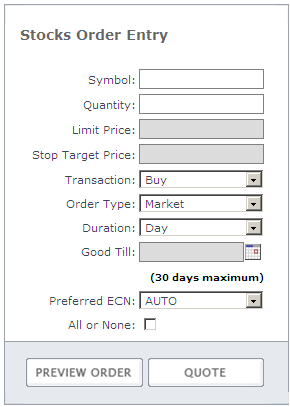
I’m going to break up my sell order, so I can demonstrate one sell with a market order and one sell with a limit order.
How to enter a market order
For my market order sell I’ll fill in the fields like so:
- Symbol = REI.UN.TO
- Quantity = 100
- Transaction = Sell
- Order Type = Market
- Duration = Day*
- Preferred ECN = AUTO
- All or None* = Leave unchecked
*Duration – “Day” means that the order will only exist until the end of the trading day. If it is unfilled at that time, then it disappears.

The next step is to verify the share price by clicking on the QUOTE button at the bottom of the form.
Now we see a pile of new information on the quote screen.
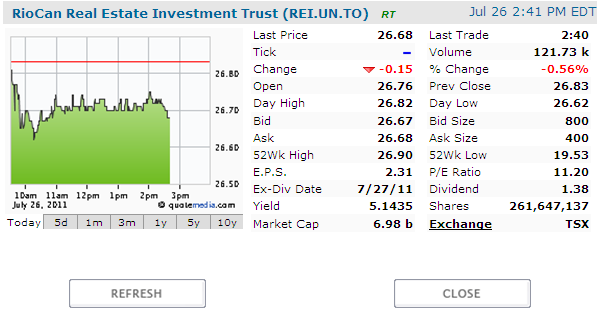
The main info I’m interested in is the Last Price which is $26.68. This has gone down a bit since I looked at the price earlier.
Next step is to click on PREVIEW ORDER
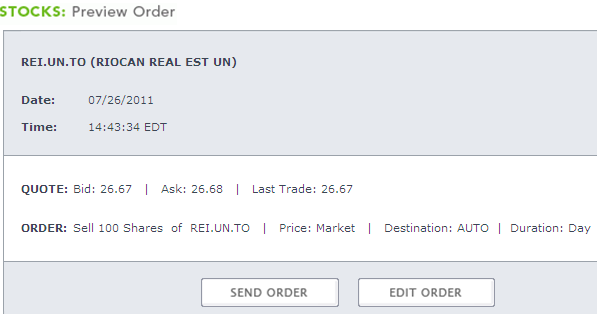
This is your last chance to verify the order information. Everything looks good, so now I will click on “SEND ORDER”.
The order was filled (or executed) instantaneously at $26.68.
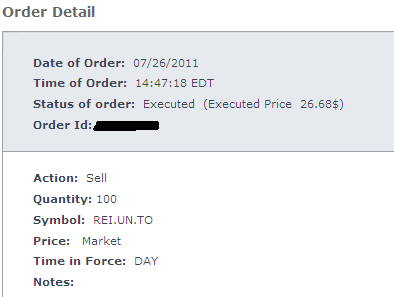
If I want to review the order details, I can click on “YOUR ACCOUNT” and “Messages”.
From this I can see the commission ($4.95) and the trade total of $2,663.05 which represents the share proceeds and commission.
Some brokerages (including Questrade) add another fee to the commission called ECN fees. They are fairly small, but if you are doing high volume trades, it can be a factor.
How to enter a limit order
Most of the steps for a limit order are the same as for a market order.
Start with “QUICK ORDER ENTRY”. The form on the right hand side is uses to enter an order.

The key difference with a limit sell is that I will be specifying a price which represents the lowest price I’m willing to sell the stock for. In the case of REI, the current market price is $26.68. If I select a limit that is lower than $26.68, the order will likely get filled at market (just like my market order) and the limit will just be there for protection.
Another strategy is to put a limit price that is higher than the current market price and hope that the market goes up and you can sell at a higher price. In this case you will have a pending order which can be cancelled. This is a good scenario for using the “GTC” or good till cancel order type so that the order doesn’t get cancelled at the end of the day.
I like to select a limit price that is just below the market price – perhaps 1 or 2% lower. In this case I’ll try setting the limit at $26.40 which is just below the market price of $26.68. If the stock is more volatile you might have to set a lower limit because the stock could jump through the limit before you place your order.
It’s not a bad idea to monitor the price movements of a stock for a little while to get a feel for the volatility. You want to set the limit low enough below the regular price points in order for the order to get filled quickly. For example if you check the price of a stock every 60 seconds and see the following: $23.12, $23.09, $23.14, that stock price is not moving around much and you can probably set a sell limit price of $23.00 and be fairly assured it will be filled.
For my limit order sell, I’ll fill in the fields like so:
- Symbol = REI.TO.UN
- Quantity = 104
- Limit Price = $26.50 Note, you have to select the order type of “Limit” before this field becomes active.
- Transaction = Sell
- Order Type = Limit
- Duration = Day
- Preferred ECN = AUTO
The next step is to verify the share price by clicking on the QUOTE button at the bottom of the form.
Now we see a pile of new information on the quote screen.

I can see that the last price for REI is $26.68.
Next step is to click on PREVIEW ORDER
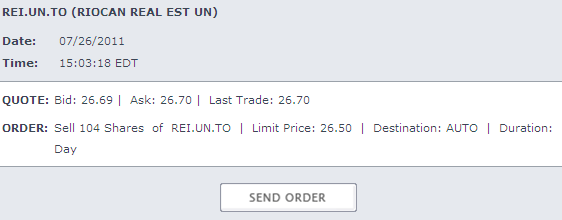
This is your last chance to verify the order information. It look good, so now I will click on “SEND ORDER”.
The order was filled (or executed) instantaneously at $26.68 which is the exact same price as my market order.
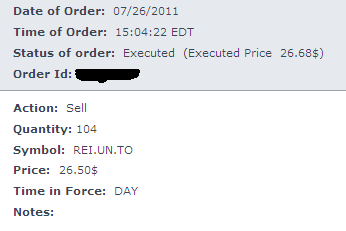
Some suggestions
If you are not familiar with placing stock or ETF trades, it can be a bit stressful if you are placing large sell orders. I suggest starting off with a small trade or two just to get familiar with the process. Yes, you will be burning a couple of commissions, but trust me – it’s worth it.
Another suggestion is to see if your brokerage offers a “test” area where you can place dummy trades to get familiar with the trading platform. Questrade offers a free trading platform trial which you can access to try some test trades.
Another option is just to use cheap index funds – they are a heck of a lot easier!
Please let me know if you have anything to add to this information based on your experience with different brokerages.

8 replies on “How To Sell An ETF Or Stock Using A Canadian Discount Brokerage”
Thanks for that. I especially appreciated the advice about watching the stock for volatility.
Once again an excellent post — very useful and well explained.
Thank you!
Nice guide Mike – very thorough! Wish I had this when I started trading on Questrade 🙂
Thanks Mike, very explicit & easy to understand. However, for tax purposes where does one find the ACB on the Questrade site for all selling trades?
Mike;
Thanks for your blog. This one is very basic but it helps those getting started.
You might want to continue this tread by describing the implications of selling (taxes), required record keeping and record keeping systems (for the non-professional trader) including paper, Excel, QUICKEN, etc.
Do you ever consult options positions as part of your sell / buy decision making process?
John
@ Maurice:
Even if Questrade lists the ACB (or Adjusted Cost Base), it is important do maintain your own records and calculations. I’ve seen brokers list an ACB of “n/a” or completely inaccurate ones. Then too – the broker’s ACB may be accurate for what is in the account but you may have other accounts that are impacting the ACB.
At the end of the day, as an investor and tax payer, it is up to you to make sure that what is reported on schedule 3 of the tax forms is accurate.
Here is a couple of links to get you started:
http://www.milliondollarjourney.com/how-investing-taxes-work-part-1.htm
http://www.milliondollarjourney.com/how-investing-taxes-work-part-2-dividends-and-interest.htm
Side Note: Since you mentioned ACB in the context of taxes, I am
using the term the same way the tax form on schedule 3 uses it, which is the total cost for the shares sold. This is important as a lot of sources will also refer to ACB but will mean ACB per share.
Cheers
Many thanks Mike, the two links you provided were a great help.
“Another option is just to use cheap index funds – they are a heck of a lot easier!”
Index mutual funds, right? You’re talking about mutual funds, not index ETFs? I ask because I would have called both “index funds”, but I’m a novice…
I am contemplating the switch to ETFs and feeling a bit intimidated by the jump in complexity. My mutual fund experience is very much “put X dollars in, take Y dollars out”, none of this “limit order” business, and I’m wondering if it’s all worth it.